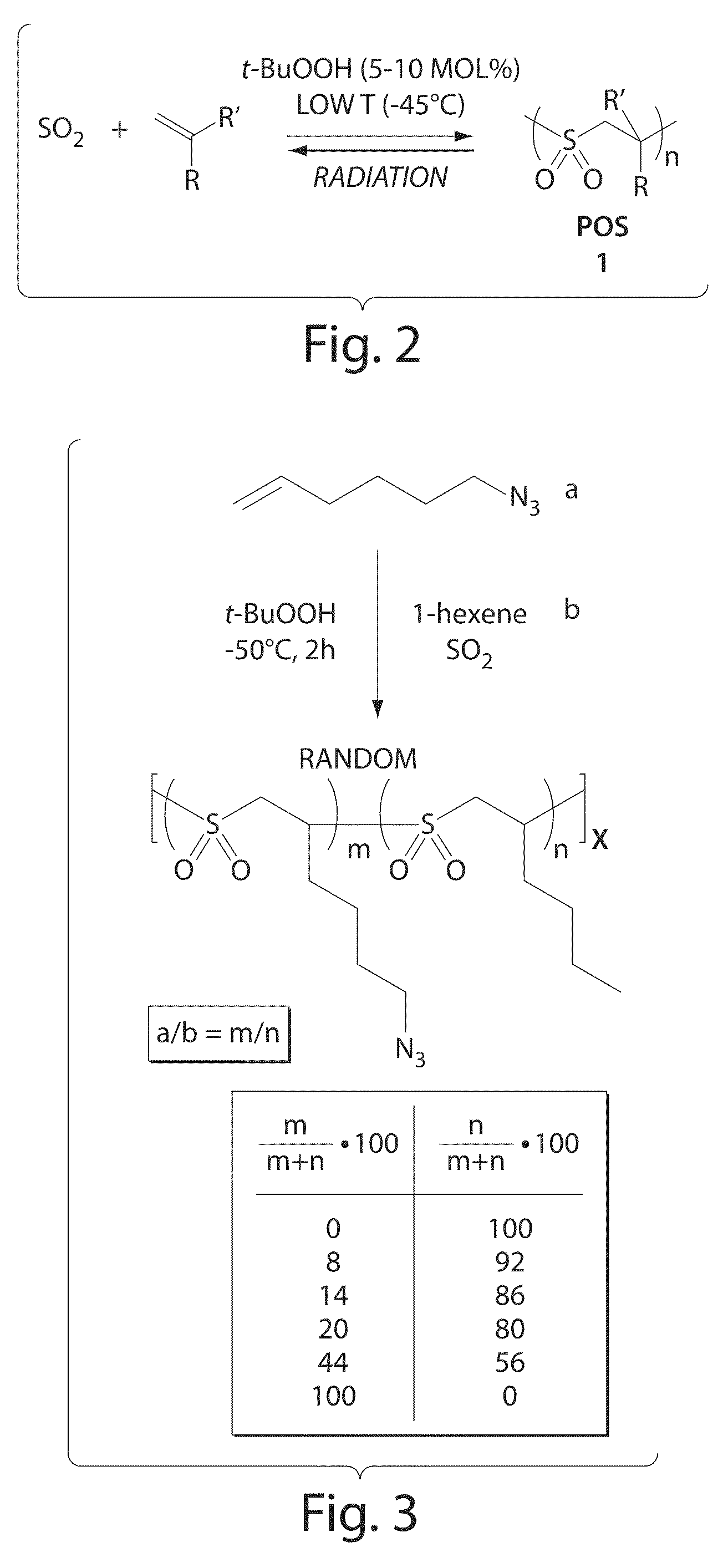Method and apparatus for determining radiation
a radiation and method technology, applied in the direction of liquid/fluent solid measurement, material electrochemical variables, instruments, etc., can solve the problems of low sensitivity to non-charged radiation, inability to produce real-time signals, and high manufacturing costs and/or complexity
- Summary
- Abstract
- Description
- Claims
- Application Information
AI Technical Summary
Problems solved by technology
Method used
Image
Examples
embodiment 1
wherein a, b, w, and n are each individually 0 or greater, R is alkyl, aryl, heteroalkyl, heteroaryl, each optionally substituted. In some cases, a, b, w, and n are each individually 1, or 2, or greater. In some cases, a and b are 1, 2, 3, 4, or 5. In some cases, a is 1 and b is 1, 2, 3, 4, 5. In some cases, R is alkyl, for example, butyl. In some cases, w is 1, 2, 3, 4, 5, or in a particular A specific example of a polymer is:
[0066]
wherein a is 1, b is 3, and n is 40. The COOH group (or COO— group) may be used to associate with a metal-containing complex or species (e.g., gadolinium). For example, see Example 15.
[0067]In another example, the polymer material may comprise optionally substituted polyaldehydes (PALs), which may depolymerize in the presence of ionizing radiation to produce aldehyde species. PALs, as shown in FIG. 8, are a class of thermodynamically unstable, but kinetically stable, polymers, which can be synthesized by anionic polymerization. Typically, PALs are stabi...
examples and embodiments
[0127]Unless otherwise noted, the reactions described in the Examples were performed under an oxygen-free atmosphere of argon. Graduated flasks were used for polymerization reactions with condensed sulfur dioxide. Anhydrous solvents were obtained using a solvent purification solvent (Innovative Technologies). All other chemicals were of reagent grade from Sigma-Aldrich and were used as received, except for sulfur dioxide, which was purchased from Airgas, and triphenylbismuthine, which was purchased from Alfa. Cuprous Bromide was purified as described somewhere else. Multi-walled carbon nanotubes were donated by Bayer, AG (Baytubes 150 P, >95% purity).
[0128]NMR spectra were obtained on a Bruker Avance (400 MHz). NMR chemical shifts are given in ppm referenced to CHCl3 / TMS (7.24 ppm for 1H, 77.24 ppm for 13C), unless otherwise noted. High-resolution mass spectra (HRMS) were obtained on a Bruker Daltonics APEXII 3 Tesla Fourier Transform Mass Spectrometer at the MIT Department of Chemi...
example 1
[0130]
[0131]The following describes a general method for POS synthesis. A typical Poly (Olefin Sulfone) synthesis was carried out following literature procedures. In general, sulfur dioxide (6 mL) was condensed into a graduated vessel at −78° C. The reaction vessel was then transferred into a −45° C. bath. Olefin monomers were added to the reaction mixture in the desired ratio, and the solution was stirred for 5 minutes. Initiator for the polymerization (tert-Butyl hydroperoxide in decane, solution 5.0-6.0M, 5-10 mol % relative to total amount of olefin) was added, and the mixture was stirred at −45° C. for 2 h. The polymerization was stopped by pouring the reaction mixture into MeOH. The resulting white powder was redissolved in CHCl3 and reprecipitated from MeOH, then washed with MeOH. The white solid obtained was dried under vacuum.
PUM
| Property | Measurement | Unit |
|---|---|---|
| mol % | aaaaa | aaaaa |
| mol % | aaaaa | aaaaa |
| particle size | aaaaa | aaaaa |
Abstract
Description
Claims
Application Information
 Login to View More
Login to View More - R&D
- Intellectual Property
- Life Sciences
- Materials
- Tech Scout
- Unparalleled Data Quality
- Higher Quality Content
- 60% Fewer Hallucinations
Browse by: Latest US Patents, China's latest patents, Technical Efficacy Thesaurus, Application Domain, Technology Topic, Popular Technical Reports.
© 2025 PatSnap. All rights reserved.Legal|Privacy policy|Modern Slavery Act Transparency Statement|Sitemap|About US| Contact US: help@patsnap.com



